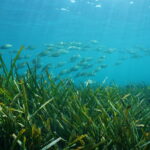In many parts of the world, water resources are under pressure due to the ever-increasing demand from growing populations and the need for increased agricultural production. Water scarcity is expected to increase in the future, in particular for the 40% of the world classified as semi-arid.
Access to water is therefore recognised as one of the main economic drivers in the semi-arid areas and the United Nations has included water use efficiency as one of the Sustainable Development Goals (SGDs) indicators. However, seen from a policy and investment perspective, there are significant knowledge gaps and uncertainties in how much water is available, used and extracted from these regions. Better data on water use is called for to improve agricultural planning.
Mapping of irrigated agriculture using satellites
Using satellite data, we can calculate the consumed water for irrigation from a number of inputs including biomass production, rainfall and soil inputs. Satellite-based calculation of evapotranspiration (ET) is key to this and reliable and robust time series of ET records are essential in improving the above.
While there are a variety of existing remote sensing ET methods and data products available (for example, the Food and Agriculture Organization’s Water Productivity Open-access portal – WaPOR), none of them fully satisfies the user needs for reliable, high-resolution, operational and easily accessible ET estimates and processing tools.
The limitations have so far primarily been centered on the input data sources (such as coarse thermal data), as well as the research and the open access to implemented methods. With the recent launch of Sentinel 2 and 3, the data foundation for creating reliable high resolution ET methods has been established.
Improved resolution and estimate of evapotranspiration worldwide
A joint effort called SEN-ET between the European Space agency (ESA), DHI GRAS, IRTA and Sandholt APS is working on reviewing and implementing methods for the earth observation estimation of ET by the fusion of Sentinel 2 and Sentinel 3 data.
Machine learning algorithms will be used to sharpen low-resolution Sentinel-3 thermal data with the high-resolution Sentinel-2 optical images. The resulting high resolution datasets are then used as input to a land-surface energy balance model to estimate ET at high spatial resolution. This will significantly improve the resolution and estimate of ET worldwide. The novelty here is therefore the downsampling of the data down to plot and farm size and the availability of seasonal data coverage allowing for full seasonal crop cycle assessment.
So much more you can do with satellites
There are many other solutions that satellite mapping can offer. An example is the ‘EO4SD’ (Earth Observation for Sustainable Development) initiative, where DHI GRAS is cooperating with international finance institutions and national stakeholders on three different continents to deliver water solutions from satellites.
Among other things, we are delivering a national map of irrigation extent for the Malawi National Water Resource Authority. This map will be integrated into the national water licensing system to compare actual licensed area with instances of non-licensed water usage.
Ultimately, this would help safeguard the environment and avoid conflicts by ensuring better monitoring and management of water resources in Malawi. This project will serve as a blueprint for other countries in the region.
 Irrigated vs non-irrigated land cover mapping in Malawi as part of EO4SD ‘Water’ Cluster. This map is crucial input to a national scale water licensing system. © DHI GRAS
Irrigated vs non-irrigated land cover mapping in Malawi as part of EO4SD ‘Water’ Cluster. This map is crucial input to a national scale water licensing system. © DHI GRAS
‘There is so much more to do related to this. Satellite remote sensing of ET is an essential part of global observation systems and provides inputs for agriculture, water resources management, weather forecasts, climate studies and many other applications. What I have described is merely the tip of the iceberg.’
Learn more
Click here to find out how satellite imagery can help you deliver solutions in a smarter way.
 Modelled evapotranspiration of Italian agricultural fields derived from satellite images. Courtesy: SEN-ET partners from Guzinski & Nieto, Evaluating the feasibility of using Sentinel-2 and Sentinel-3 satellites for high-resolution evapotranspiration estimations).
Modelled evapotranspiration of Italian agricultural fields derived from satellite images. Courtesy: SEN-ET partners from Guzinski & Nieto, Evaluating the feasibility of using Sentinel-2 and Sentinel-3 satellites for high-resolution evapotranspiration estimations).








